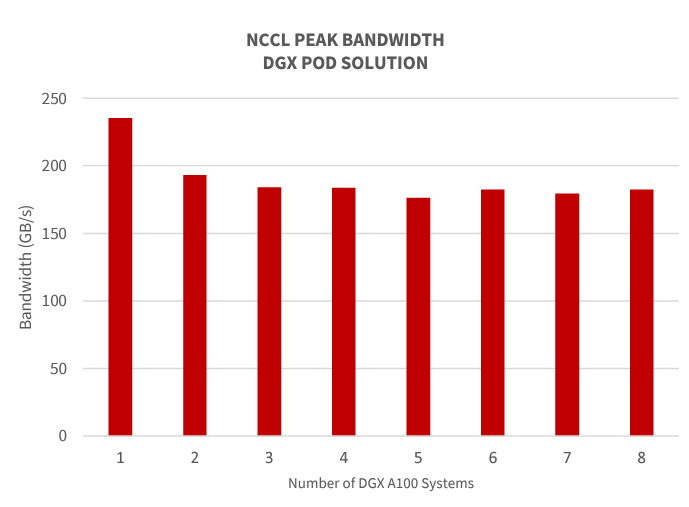DDN A³I Enablement for NVIDIA DGX BasePOD
DDN A³I solutions (Accelerated, Any-Scale AI) are architected to achieve the most from at-scale AI, Data Analytics and HPC applications running on DGX systems and DGX BasePOD. They provide predictable performance, capacity, and capability through a tight integration between DDN and NVIDIA systems. Every layer of hardware and software engaged in delivering and storing data is optimized for fast, responsive, and reliable access.
DDN A³I solutions are designed, developed, and optimized in close collaboration with NVIDIA. The deep integration of DDN AI appliances with DGX systems ensures a reliable experience. DDN A³I solutions are highly configured for flexible deployment in a wide range of environments and scale seamlessly in capacity and capability to match evolving workload needs. DDN A³I solutions are deployed globally and at all scale, from a single DGX system all the way to one of the largest NVIDIA DGX SuperPOD™ configurations in operation today.
DDN brings the same advanced technologies used to power the world’s largest supercomputers in a fully integrated package for DGX systems that’s easy to deploy and manage. DDN A³I solutions are proven to maximum benefits for at-scale AI, Analytics and HPC workloads on DGX systems.
This section describes the advanced features of DDN A³I Solutions for DGX BasePOD.
DDN A³I Shared Parallel Architecture
The DDN A³I shared parallel architecture and client protocol ensures high levels of performance, scalability, security, and reliability for DGX systems. Multiple parallel data paths extend from the drives all the way to containerized applications running on the GPUs in the DGX system. With DDN’s true end-to-end parallelism, data is delivered with high-throughput, low-latency, and massive concurrency in transactions. This ensures applications achieve the most from DGX systems with all GPU cycles put to productive use. Optimized parallel datadelivery directly translates to increased application performance and faster completion times.
The DDN A³I shared parallel architecture also contains redundancy and automatic failover capability to ensure high reliability, resiliency, and data availability in case a network connection or server becomes unavailable.
DDN A³I Streamlined Deep Learning
DDN A³I solutions enable and accelerate end-to-end data pipelines for deep learning (DL) workflows of all scale running on DGX systems. The DDN shared parallel architecture enables concurrent and continuous execution of all phases of DL workflows across multiple DGX systems. This eliminates the management overhead and risks of moving data between storage locations. At the application level, data is accessed through a standard, highly interoperable file interface, for a familiar and intuitive user experience.
Significant acceleration can be achieved by executing an application across multiple DGX systems in a DGX BasePOD simultaneously and engaging parallel training efforts of candidate neural networks variants. These advanced optimizations maximize the potential of DL frameworks. DDN works closely with NVIDIA and its customers to develop solutions and technologies that allow widely used DL frameworks to run reliably on DGX systems.
DDN A³I Multirail Networking
DDN A³I solutions integrate a wide range of networking technologies and topologies to ensure streamlined deployment and optimal performance for AI infrastructure. Latest generation InfiniBand and Ethernet provide both high-bandwidth and low-latency data transfers between applications, compute servers and storage appliances. For DGX BasePOD, DDN recommends an InfiniBand Network with NVIDIA network switches. DDN A³I Multirail greatly simplifies and optimizes DGX system networking for fast, secure, and resilient connectivity.
DDN A³I Multirail enables grouping of multiple network interfaces on a DGX system to achieve faster aggregate data transfer capabilities. The feature balances traffic dynamically across all the interfaces, and actively monitors link health for rapid failure detection and automatic recovery. DDN A³I Multirail makes designing, deploying, and managing high-performance networks very simple, and is proven to deliver complete connectivity for at-scale infrastructure for DGX BasePOD deployments.
DDN A³I Container Client
Containers encapsulate applications and their dependencies to provide simple, reliable, and consistent execution. DDN enables a direct high-performance connection between the application containers on the DGX A100 system and the DDN parallel filesystem. This brings significant application performance benefits by enabling low latency, high-throughput parallel data access directly from a container. Additionally, the limitations of sharing a single host-level connection to storage between multiple containers disappear. The DDN in-container filesystem mounting capability is added at runtime through a universal wrapper that does not require any modification to the application or container.
Containerized versions of popular DL frameworks specially optimized for the DGX systems are available from NVIDIA. They provide a solid foundation that enables data scientists to rapidly develop and deploy applications on the DGX system. The DDN A³I container client provides high-performance parallelized data access directly from containerized applications on the DGX system. This provides containerized DL frameworks with the most efficient dataset access possible, eliminating all latencies introduced by other layers of the computing stack.
DDN A³I Multitenancy
Container clients provide a simple and very solid mechanism to enforce data segregation by restricting data access within a container. DDN A³I makes it very simple to operate a secure multitenant environment at-scale through its native container client and comprehensive digital security framework. DDN A³I multitenancy makes it simple to share DGX systems across a large pool of users and still maintain secure data segregation. Multi-tenancy provides quick, seamless, dynamic DGX system resource provisioning for users. It eliminates resource silos, complex software release management, and unnecessary data movement between data storage locations. DDN A³I brings a very powerful multitenancy capability to DGX systems and makes it very simple for customers to deliver a secure, shared innovation space, for at-scale data-intensive applications.
Containers bring security challenges and are vulnerable to unauthorized privilege escalation and data access. The DDN A³I digital security framework provides extensive controls, including a global root_squash to prevent unauthorized data access or modification from a malicious user, and even if a node or container are compromised.
DDN A³I Hot Pools
Hot Pools deliver user transparent automatic migration of files between the Flash tier (Hot Pool) to HDD tier (Cool Pool). Hot Pools is designed for large scale operations, managing data movements natively and in parallel, entirely transparently to users. Based on mature and well tested file level replication technology, Hot Pools allows organizations to optimize their economics – scalingHDD capacity and/or Flash performance tiers independently as they grow.
DDN A³I S3 Data Services
DDN S3 Data Services provide hybrid file and object data access to the shared namespace. The multi-protocol access to the unified namespace provides tremendous workflow flexibility and simple end-to-end integration. Data can be captured directly to storage through the S3 interface and accessed immediately by containerized applications on a DGX system through a file interface. The shared namespace can also be presented through an S3 interface, for easy collaboration with multisite and multicloud deployments. The DDN S3 Data Services architecture delivers robust performance, scalability, security, and reliability features.
DDN A³I Advanced Optimizations for DGX A100 System Architecture
The DDN A³I client’s NUMA-aware capabilities enable strong optimization for DGX systems. It automatically pins threads to ensure I/O activity across the DGX system is optimally localized, reducing latencies and increasing the utilization efficiency of the whole environment. Further enhancements reduce overhead when reclaiming memory pages from page cache to accelerate buffered operations to storage. The DDN A³I client software for DGX A100 systems has been validated at-scale with one of the largest DGX SuperPOD deployment currently in operation.
DDN A³I Solutions with NVIDIA DGX A100 Systems
The DDN A³I scalable architecture integrates DGX A100 systems with DDN AI shared parallel file storage appliances and delivers fully optimized end-to-end AI, Analytics and HPC workflow acceleration on GPUs. DDN A³I solutions greatly simplify the deployment of DGX A100 systems in DGX BasePODconfigurations, while also delivering performance and efficiency for maximum GPU saturation, and high levels of scalability. This section describes the components integrated in DDN A³I Solutions for DGX BasePOD.
DDN AI400X2 Appliance
The AI400X2 appliance is a fully integrated and optimized shared data platform with predictable capacity, capability, and performance. Every AI400X2 appliance delivers over 90 GB/s and 3M IOPS directly to DGX A100 systems in the DGX BasePOD. Shared performance scales linearly as additional AI400X2 appliances are integrated to the DGX BasePOD. The all-NVMe configuration provides optimal performance for a wide variety of workload and data types and ensures that DGX BasePOD operators can achieve the most from at-scale GPU applications, while maintaining a single, shared, centralized data platform.
The AI400X2 appliance integrates the DDN A³I shared parallel architecture and includes a wide range of capabilities described in section 1, including automated data management, digital security, and data protection, as well as extensive monitoring. The AI400X2 appliances enables DGX BasePOD operators to go beyond basic infrastructure and implement complete data governance pipelines at-scale.
The AI400X2 appliance communicates with DGX A100 system over InfiniBand, Ethernet, and Roces. It is available in 30, 60, 120, 250 and 500 TB all-NVMe capacity configurations. Optional hybrid configurations with integrated HDDs are also available for deployments requiring highdensity deep capacity storage. Contact DDN Sales for more information.
NVIDIA DGX A100 System
The NVIDIA DGX A100 system is the universal system for all AI workloads, offering unprecedented compute density, performance, and flexibility in the world’s first 5 petaFLOPS AI system. Built on the revolutionary NVIDIA A100 Tensor Core GPU, the DGX A100 system unifies data center AI infrastructure, running training, inference, and analytics workloads simultaneously with ease. More than a server, the DGX A100 system is the foundational building block of AI infrastructure and part of the NVIDIA end-to-end data center solution created from over a decade of AI leadership by NVIDIA. The DGX A100 system integrates exclusive access to a global team of AI-fluent experts that offer prescriptive planning, deployment, and optimization expertise to help fast-track AI transformation.
NVIDIA Switches
NVIDIA network switches provide optimal interconnect for DGX BasePOD. DDN recommends InfiniBand technology for data-intensive compute and storage networks in the DGX BasePOD. The NVIDIA Quantum QM8700 HDR 200Gb/s InfiniBand Switch provides 40 ports of connectivity in a 1U form factor. Every switch is capable of up to 16Tb/s of non-blocking bandwidth with sub 130ns port-to-port latency. The QM8700 is the ideal modular network unit to architect scalable solutions with DGX BasePOD, with no compromise.
For customers that require Ethernet or RoCE, the NVIDIA Spectrum SN3700 Open Ethernet switch provides 32 ports of 200 GbE in a compact 1U form factor. It enables connectivity to endpoints at different speeds and carries a throughput of 12.8Tb/s, with full port speed flexibility from 10 GbE to 200 GbE per port. This makes it simple to integrate DGX BasePOD within any existing Ethernet environment and achieve optimal performance for data-intensive compute and storage networks.
The NVIDIA AS4610 Data Center Open Ethernet Switch is a Gigabit Ethernet Layer 3 switch family featuring 54 ports with 48 10/100/1000BASE-T ports, 4 x 10G SFP+ uplink ports. It provides robust capabilities for critical low-intensity traffic like DGX BasePOD component management.
NVIDIA Software
The value of the DGX BasePOD architecture extends well beyond its hardware. The DGX BasePOD is a complete solution providing all the major components for system management, job management, and optimizing workloads to ensure quick deployment, ease of use, and high availability (HA). The software stack begins with the DGX Operating System (DGX OS), which) is tuned and qualified for use on DGX A100 systems. The DGX BasePOD contains a set of tools to manage the deployment, operation, and monitoring of the cluster. NVIDIA NGC™ is a key component of the DGX BasePOD, providing the latest DL frameworks. NGC provides packaged, tested, and optimized containers for quick deployment, ease of use, and the best performance on NVIDIA GPUs. Lastly, key tools like CUDA-X, Magnum IO, and RAPIDS provide developers the tools they need to maximize DL, HPC, and data science performance in multi-node environments.
NVIDIA NGC
NVIDIA NGC provides a range of options that meet the needs of data scientists, developers, and researchers with various levels of AI expertise. These users can quickly deploy AI frameworks with containers, get a head start with pre-trained models or model training scripts, and use domain specific workflows and Helm charts for the fastest AI implementations, giving them faster time-to-solution.
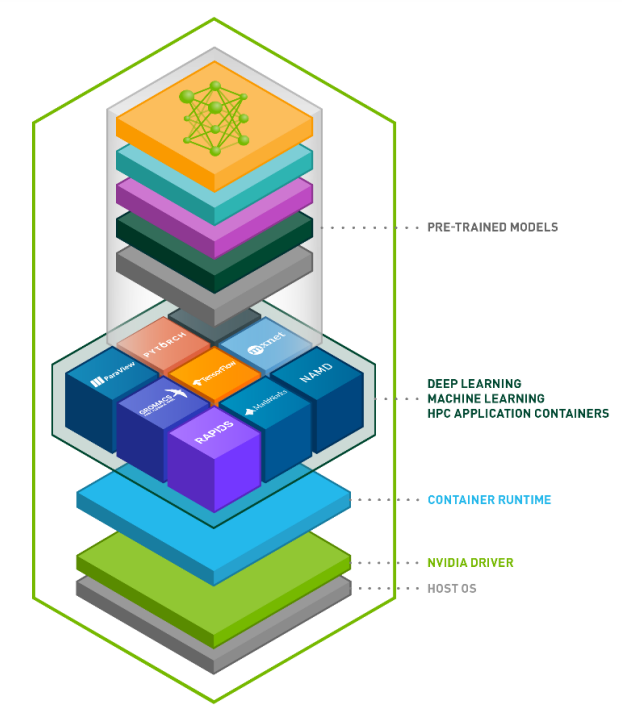
Spanning AI, data science, and HPC, the container registry on NGC features an extensive range of GPU-accelerated software for NVIDIA GPUs. The NGC hosts containers for the top AI and data science software. Containers are tuned, tested, and optimized by NVIDIA. Other containers for additional HPC applications and data analytics are fully tested and made available by NVIDIA as well. NGC containers provide powerful and easy-to-deploy software proven to deliver the fastest results, allowing users to build solutions from a tested framework, with complete control.
NGC offers step-by-step instructions and scripts for creating DL models, with sample performance and accuracy metrics to compare your results. These scripts provide expert guidance on building DL models for image classification, language translation, text-to-speech and more. Data scientists can quickly build performance-optimized models by easily adjusting hyperparameters. In addition, NGC offers pre-trained models for a variety of common AI tasks that are optimized for NVIDIA Tensor Core GPUs and can be easily re-trained by updating just a few layers, saving valuable time.
DDN A³I Reference Architectures for DGX BasePOD
DDN proposes the following reference architectures for multi-node DGX BasePOD configurations. DDN A³I solutions are fully validated with NVIDIA and already deployed with several DGX BasePOD customers worldwide.
The DDN AI400X2 appliance is a turnkey appliance for at-scale DGX deployments. DDN recommends the AI400X2 appliance as the optimal data platform for DGX BasePOD designs with the DGX A100 system. The AI400X2 appliances delivers optimal GPU performance for every workload and data type in a dense, power efficient 2RU chassis. The AI400X2 appliance simplifies the design, deployment, and management of a DGX BasePOD and provides predictable performance, capacity, and scaling. The AI400X2 appliance arrives fully configured, ready to deploy and installs rapidly. The appliance is designed for seamless integration with DGX systems and enables customers to move rapidly from test to production. As well, DDN provides complete expert design, deployment, and support services globally. The DDN field engineering organization has already deployed dozens of solutions for customers based on the A³I reference architectures.
As general guidance, DDN recommends an AI400X2 appliance for up to eight DGX A100 systems in a DGX BasePOD. These configurations can be adjusted and scaled easily to match specific workload requirements. For the storage network, DDN recommends HDR200 technology in a non-blocking network topology, with redundancy to ensure data availability. DDN recommends use of at least two HDR200 connections per DGX A100 system to the storage network.
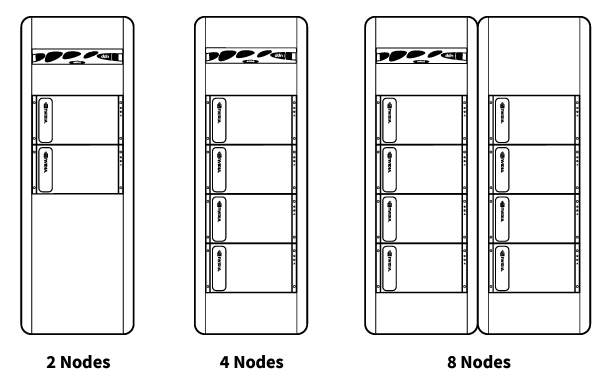
DGX BasePOD Network Architecture
The DGX BasePOD reference design includes four networks:
Storage network. Provides data transfer between the AI400X2 appliance and the compute nodes. Connects eight ports from each AI400X2 appliance. Connects two ports from each DGX A100 system, one each from two dual-port NVIDIA ConnectX®-6 HCAs. These may be configured as InfiniBand or Ethernet mode.
Compute network. Provides inter-node communication. Connects the eight single-port ConnectX-6 HCAs from each DGX A100 system. These may be configured in InfiniBand or Ethernet mode.
Management Network. Provides management and monitoring for all DGX BasePOD components. Connects the 1 GbE RJ45 Management port and 1 GbE RJ45 BMC port from each DGX A100 system and each AI400X2 appliance controller to an Ethernet switch.
(Optional) Cluster Network. Provides provisioning and job scheduling. Uses 100 GbE QSFP56 port on each DGX A100 system and optional external servers.
An overview of the DGX BasePOD network architecture is shown, recommended network connections for each DGX A100 system on Figure 9, and recommended network connections for each DDN AI400X2 appliance on Figure 10.

DGX A100 Systems Network Connectivity
For DGX BasePOD, DDN recommends ports 1 to 8 on the DGX A100 systems be connected to the computer network. DDN recommends that all DGX A100 systems in the DGX BasePOD be equipped with the 2nd dual-port HCA card, with ports 9 and 11 be connected to the storage network. For DGX A100 systems with a single dual-port HCA card installed, DDN recommends ports 9 and 10 be connected to the storage network. As well, the management (“M”) and BMC (“B”) ports should be connected to the management network.

AI400X2 Appliance Network Connectivity
For DGX BasePOD, DDN recommends ports 1 to 8 on the AI400X2 appliance be connected to the storage network. As well, the management (“M”) and BMC (“B”) ports for both controllers should be connected to the management network. Note that each AI400X2 appliance requires one inter-controller network port connection (“I” ) using short ethernet cable supplied.

DGX BasePOD with Two DGX A100 systems
DDN A³I architecture in a 1:2 configuration in which two DGX A100 system are connected to an AI400X2 appliance through a pair of network switches that are configured for HA. Every DGX A100 system connects to each of the storage network switches via one HDR 200Gb/s InfiniBand or 200 GbE link. The AI400X2 appliance connects to each of the storage network switches via four HDR 200Gb/s InfiniBand or 200 GbE links. The storage network switches are interconnected with four dedicated links. This ensures non-blocking data communication between every device connected to the network. The HA design provides full-redundancy and maximum data availability in case of component failure in one of the devices.
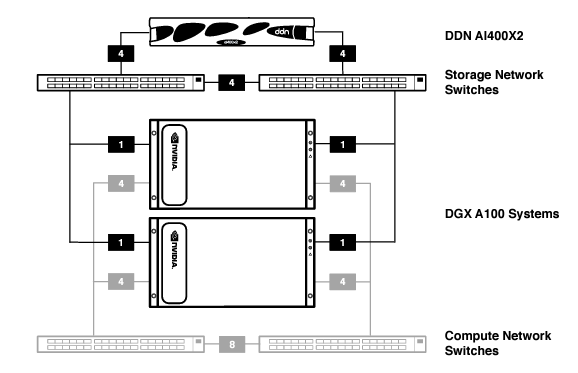
DGX BasePOD with Four DGX A100 systems
DDN A³I architecture in a 1:4 configuration in which four DGX A100 systems are connected an AI400X2 appliance through a pair of network switches that are configured for HA. Every DGX A100 system connects to each of the storage network switches via one HDR 200Gb/s InfiniBand or 200 GbE link. The AI400X2 appliance connects to each of the storage network switches via four HDR 200Gb/s InfiniBand or 200 GbE links. The storage network switches are interconnected with four dedicated links. This ensures non-blocking data communication between every device connected to the network. The HA design provides full-redundancy and maximum data availability in case of component failure in one of the devices.
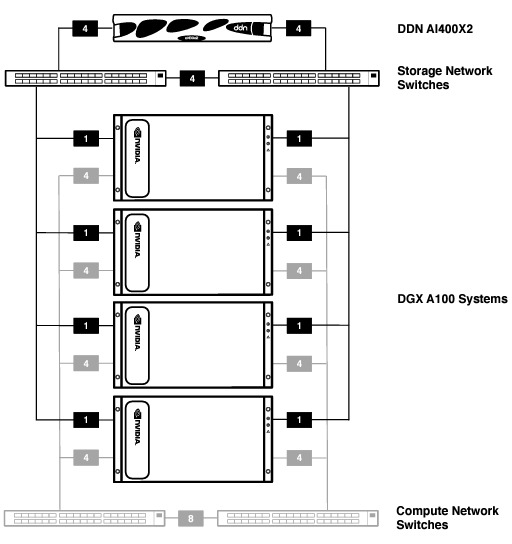
DGX BasePOD with Eight DGX A100 Systems
DDN A³I architecture in a 1:8 configuration in which eight DGX A100 systems are connected to one AI400X2 appliance through a pair of network switches that are configured for HA. Every DGX A100 system connects to each of the storage network switches via one HDR 200Gb/s InfiniBand or 200 GbE link. The AI400X2 appliance connects to each of the storage network switches via four HDR 200Gb/s InfinBand or 200 GbE links. The storage network switches are interconnected eight dedicated links. This ensures non-blocking data communication between every device connected to the network. The HA design provides full redundancy and maximum data availability in case of component failure in one of the devices.
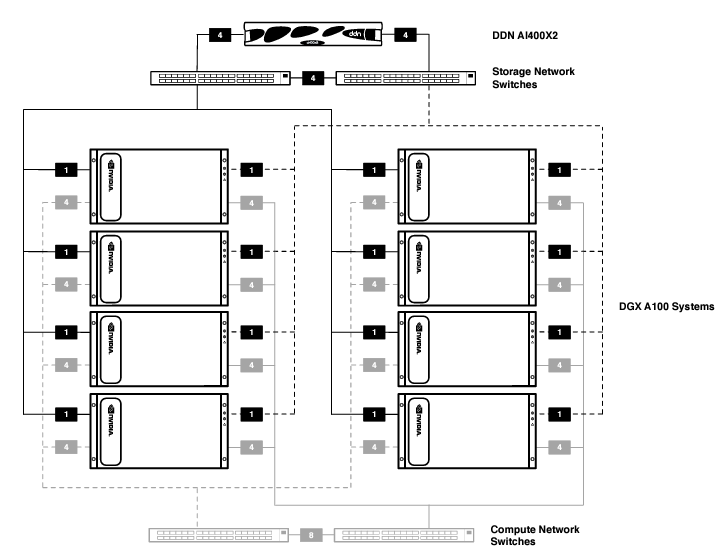
Optional Management Servers
The DGX BasePOD reference design includes three optional servers for advanced cluster management like resource provisioning and job scheduling. The servers integrate seamlessly with the DDN A³I Reference Architectures for DGX BasePOD with two, four and eight DGX A100 systems configurations. The servers connect to the same storage and management network as the DGX A100 systems and AI400X2 appliances. This enables direct access to the shared filesystem from the servers, and provides connectivity with DGX A100 systems for cluster operations. For DGX BasePOD configurations that require very high-throughput cluster management, a dedicated 100 GbE network can be deployed to connect the DGX A100 systems with the servers. Contact DDN Sales to discuss optional server configurations and ensure optimal end-to-end integration is achieved for both infrastructure and applications.
DDN A³I Solutions with NVIDIA DGX BasePOD Validation
DDN conducts extensive engineering integration, optimization, and validation efforts in close collaboration with NVIDIA to ensure best possible end-user experience using the reference designs in this document. The joint validation confirms functional integration, and optimal performance out-of-the-box for DGX BasePOD configurations.
Performance testing on the DDN A³I architecture has been conducted with industry standard synthetic throughput and IOPS applications, as well as widely used DL frameworks and data types. The results demonstrate that with the DDN A³I shared parallel architecture, containerized applications can engage the full capabilities of the data infrastructure and the DGX A100 systems. Performance is distributed evenly across all the DGX A100 systems in the DGX BasePOD, and scales linearly as more DGX A100 systems are engaged.
This section details some of the results from recent at-scale testing integrating AI400X2 appliances with up to eight DGX A100 systems.
The tests described in this section were executed in an NVIDIA data center on eight DGX A100 system equipped with eight A100 GPUs and one AI400X2 appliance running DDN EXAScaler 6.0.1.
For the storage network, all eight DGX A100 systems are connected to a QM8700 switch with two HDR 200Gb/s InfiniBand links, one per dual-ported adapter (see recommendation in section 3.1). The AI400X2 appliance is connected to the same network with eight HDR 200Gb/s InfiniBand links. For the compute network, all eight DGX A100 systems are connected to a nonblocking HDR 200Gb/s InfiniBand network. All eight-single ported network adapters on the DGX A100 systems are connected to the compute network.
This test environment allows us to demonstrate performance with the largest possible DGX BasePOD configuration.

DGX BasePOD FIO Performance Validation
This series of tests demonstrate the peak performance of the DDN BasePOD reference architecture using the fio open-source synthetic benchmark tool. The tool is set to simulate a general purpose workload without any performance-enhancing optimizations. Separate tests were run to measure both 100% read and 100% write workload scenarios.
Below are the specific FIO configuration parameters used for these tests:
- blocksize = 1024k
- ioengine = posixaio
- direct = 1
- bw-threads = 255
- iodepth= 128
The AI400X2 appliance provides predictable, scalable performance. This test demonstrates the architecture’s ability to deliver full throughput performance to a small number of clients and distribute the full performance of the DDN solution evenly as all DGX A100 systems are engaged.
The test results demonstrate that DDN solution can deliver over 45 GB/s of read and write throughput to a single DGX A100 system, and evenly distribute the full read and write performance of the AI400X2 appliance with up to eight DGX A100 systems engaged simultaneously. The DDN solution can fully saturate both network links on every DGX A100 system, ensuring optimal performance for a very wide range of data access patterns and data types for applications running on DGX A100 systems in a DGX BasePOD.

DGX BasePOD MLPERF Performance Validation
Application benchmarks provide important validation and measurements that characterize DGX BasePOD performance beyond infrastructure performance. The MLPerf benchmarks include a variety of different DL models with different I/O requirements, representative of common DL workloads. As demonstrated in the following tests, integrated solution delivers scalable infrastructure and application performance for a wide variety of DL workloads running on DGX BasePOD.
ResNet-50 is the current standard for DL benchmarks. It is an I/O intense workload, processing over 20,000 images per second on a DGX A100 system. The average size of an image in the ImageNet database is 125 KB. This translates into needing to read data at approximately 3 GB/s. For the largest DGX BasePOD with eight DGX A100 systems configurations, the DL workflows requires up to 24 GB/s of read throughput from a shared data repository. A single AI400X2 appliance delivers nearly four times the required performance and provides ample headroom to meet rapidly evolving application needs.
Illustrating application performance as multiple nodes are engaged in the DGX BasePOD. The application on DGX BasePOD achieves linear performance scaling as more nodes are engaged.

DGX BasePOD NCCL Performance Validation
The NVIDIA Collective Communications Library (NCCL) implements multi-GPU and multi-node collective communication primitives that are performance optimized for NVIDIA GPUs and Networking. This NCCL test is intended to verify scalability across multiple DGX A100 systems to ensure there are no inherent bottlenecks for GPU-to-GPU communication within subsequent benchmarks.
The results of the NCCL test demonstrate that a single node achieves the full internal NVIDIA NVLink™ capabilities of a DGX A100 system, slightly over 235 GB/s. With multiple nodes engaged, the test demonstrate that the compute network can ensure full network capabilities with up to eight DGX A100 systems engaged simultaneously. This test demonstrates that the compute network in the DDN BasePOD Reference Architecture is fully non-blocking and capable of delivering data to all 64 A100 GPUs with no-compromise to performance and allows limitless flexibility for applications that can take advantage of multiple GPUs within a single DGX A100 system, or across all nodes in the DGX BasePOD.
